There’s an old adage among beekeepers that says if you ask five of them for apiary-related advice, you’ll end up with six different opinions. I’m beginning to think that it’s much the same state of affairs with permaculture: the more I study, the more I find myself spiralling off in different directions or wading through a wealth of diverse ideas on a single subject. In a way, I suppose this is a good thing. After all, it must surely be proof that permaculture is a vibrant and evolving movement and that so many people involved aren’t simply following like sheep but thinking laterally and bringing their own energy and innovation to the field. It certainly makes it an endlessly fascinating and thought-provoking area for contemplation! I have to admit, though, that I keep coming back to David Holmgren’s twelve key principles as the basis for my own practice, partly because he is one of the founding fathers and I like what he says, but also because I think they provide a useful set of tools which suits my way of thinking. As we finally emerge from what has been a year of extraordinary weather coupled with two months where I have been largely out of action, Principle 1 ‘Observe and interact’ has been very much at the forefront of my mind this week . . . as well as what to do with the wonderful daily harvest we are still enjoying. 😊

For me, observation is as much about having an open mind as open eyes; it’s all very well wandering about assessing how well things have or haven’t stood up to the difficult conditions but making decisions about how to move forward or what to change (the ‘interact’ bit) may need several different lines of thought. This is partly because to some extent, we are dealing in unknowns: last year was abnormally cool and wet, this year abnormally hot and dry . . . who’s to say what next year will bring? In the absence of a crystal ball, we need to prepare for all eventualities and be ready to adapt our plans as we go along. Something that has been apparent is how well the lasagne beds and Hügel beds have held up, despite being newly-established and seriously short of rain since last September. They will definitely be the model for any future planting areas we create: I think I can safely say our digging days are over.

One of the things that has struck me this week is how much better the hedges that Roger laid last winter are looking in comparison to the others. Although it might seem like a drastic thing to do at the time, this traditional approach to hedge maintenance reaps dividends in the long run, encouraging rejuvenation from the base and the renewal of the hedge’s life cycle in a way that the common practice of over- management, mechanical flailing and hard trimming to the same height every year cannot do. I don’t think it’s any coincidence that the laid hedges are currently abundant in growth and green leaves and so thick that it’s impossible to see daylight through them whereas the others have been yellowing and shedding leaves at a rate of knots for some time now. We are on red alert to stop the council contractors from siding and topping the boundary hedge along the lane when they inevitably pass through on their tractors as that is the next one to be laid once the dormant period arrives. It’s a slow job but an ancient country craft well worth preserving and if it makes our hedges of native plants more robust and resilient, then it’s definitely worth the effort.
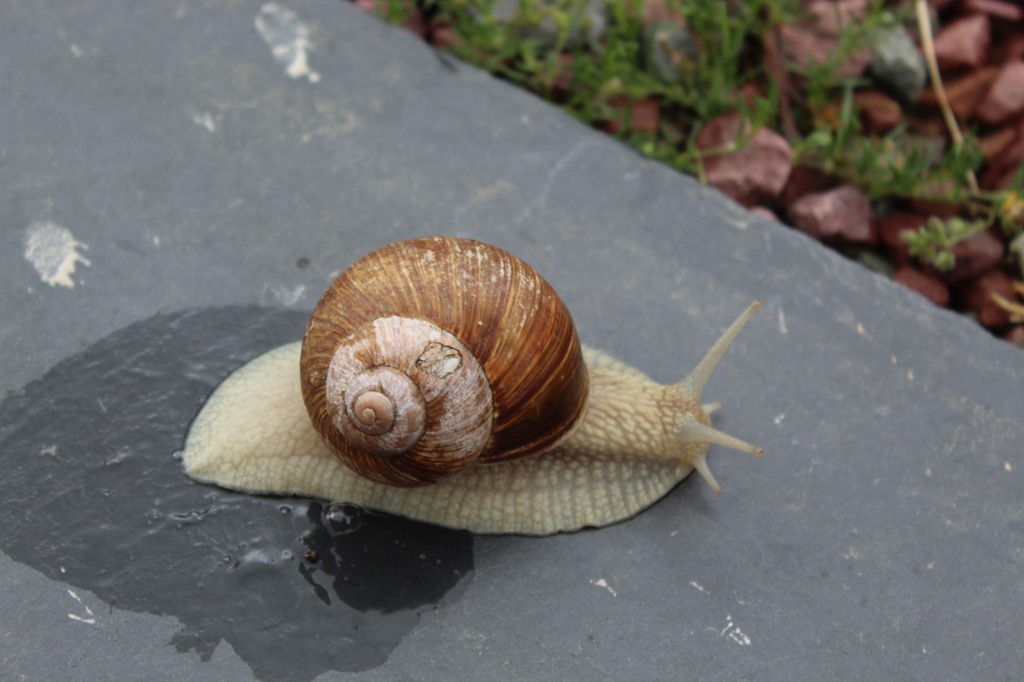
An undisputable benefit of good hedges is the habitat they provide for wildlife and it’s been noticeable this week just how many late fledges of young birds have been flitting around the garden, including blue tits, greenfinches and goldfinches. The latter are particularly active, little washed-out versions of their brightly-coloured parents feasting on an abundance of seeds around the garden with a special liking for the cosmos in the potager. Watching them swaying on the delicate stems and tucking in to the copious seedheads with their perfectly adapted tweezer beaks, I was reminded once more how important it is to always include such beneficial flowers in our planting plans.


I’m saving more seed than ever this year, both food and flowers, and one benefit of the weather is that they are all beautifully dry ~ which is a good thing, as I’m running out of space indoors for processing them all. Where flowers are concerned, we’ve already reached a point where certain characters are readily self-setting all over the place: we will certainly never have to buy calendula, borage, phacelia, buckwheat, Californian poppy or pansy seed ever again and there has been an encouraging number of cosmos, verbena and rudbeckia volunteers this year, too. Whether I will be able to salvage any viable sunflower seed for planting and the winter bird table is anybody’s guess at the moment as every ripe head becomes a feeding frenzy of birds, not just the predictable finches but also a good number of great tits and coal tits. Well, they can only eat them once!

Taking the time to look properly around the somewhat neglected garden, I was delighted to find a few pleasant surprises. I like to indulge in a bit of companion planting, albeit often in a very informal way, so for that reason I’m happy to let dill spread itself far and wide (there’s another seed we’ll never need to buy again). It’s a great culinary and medicinal herb, the flowers are attractive to helpful predators like hoverflies and parasitic wasps and at the same time, the smell is said to deter white butterflies so it’s particularly useful around brassicas. Nasturtiums are another helpful plant when it comes to an integrated pest management system and so I poked a few seeds in among the summer brassicas as a sacrificial plant for when those dratted butterflies appeared on the scene. Where the dill has revelled in a wonderful summer, the poor nasturtiums have hated it; in fact, the only ones that have grown are self-set volunteers from last year (and I think there’s a lesson there, somewhere). So, I was very pleased to find a couple of courageous little souls flowering beneath the cabbages, brave splashes of orange sunshine amongst the tired foliage, and with any luck they’ll be back next year. It’s been a tough season for the brassicas, too, not helped by the fact that there has been no let-up in flea beetle activity, but I did find a couple of gems. First, some crisp stems of green calabrese . . .

. . . and then ~ drum roll, please ~ a cauliflower! Well, okay, it’s not much of a cauliflower and I admit one out of twelve is hardly anything to crow about, but these were very definitely an experiment this summer and under the circumstances, I’m amazed even this one survived.

The caulis were a wild card this year and I believe very strongly that we musn’t be afraid to experiment, to push against the boundaries of perceived wisdom, taking ourselves beyond our comfort zone and into those marginal areas of thinking and doing that permaculture sees as such rich and fertile places (Principle 11 ‘Use edges and value the marginal’). Orthodoxy and tradition are good starting points for most things but when we are dealing with uncertainty and change, then we need to be flexible and open to new ideas . . . not to mention that being a bit of a rebel now and then can be fun, especially when it brings success! A good case in point is the asparagus bed that I created last year, first doing lots of research and reading into the dos and don’ts and then completely ignoring all advice and going full pelt down the maverick route.

| Conventional advice | What I did |
| Clear ground of all weeds, especially perennials. | Spread cardboard over grass and weeds and soaked with rainwater. |
| Dig a deep trench and fill with rotted manure and/or compost. | Piled on several layers of organic matter, all to hand on our patch, to make a lasagne bed. |
| Create a ridge, plant crowns of F1 male plants and cover with more compost. | Raised non-F1 plants from seed, planted each into a deep pocket of homemade compost and mulched the lot with hay. |
| Under no circumstances allow the plants to dry out, especially in prolonged spells of hot weather. | Watered the plants initially last year until established; this year, they have barely been watered despite the drought. |
| Do not harvest spears until the third year (crowns) or fourth year (seeds). | Mmm, we’ll see about that one . . . 😉 |
If I’m honest, my approach was based as much on laziness and impatience as anything else. The idea of clearing and digging such a huge patch of grassland and hauling all that compost didn’t appeal any more than having to wait until autumn to buy crowns (and the price of those compared to a packet of seeds soon had me sowing rather than ordering). I didn’t want the work or the wait, Charles Dowding assured me a no-dig bed was possible so I just went for it; to quote the mantra Roger and I have used a great deal over the years, what’s the worst that could happen?

As you can see, the asparagus bed is currently full of vibrant green ferny foliage, some of the plants being almost as tall as I am; they haven’t suffered at all through the heat and drought and are, in fact, still sending up thick spears. Inevitably, there are some female plants among them but I’m really not bothered as they will still produce spears (with 30 plants, we will have more than enough asparagus anyway) and I can’t imagine that whipping out any seedlings that might appear is as onerous a task as some horticulturists make out. The only weeds to have appeared in the bed are a few clumps of sorrel which are easily pulled and scattered on the surface; I shall soon be giving the plants a feed of compost and manure then I’ll chop and drop the ferns around them once they have died back to add another layer of organic material to the bed. No dig? No problem, I say. 😃
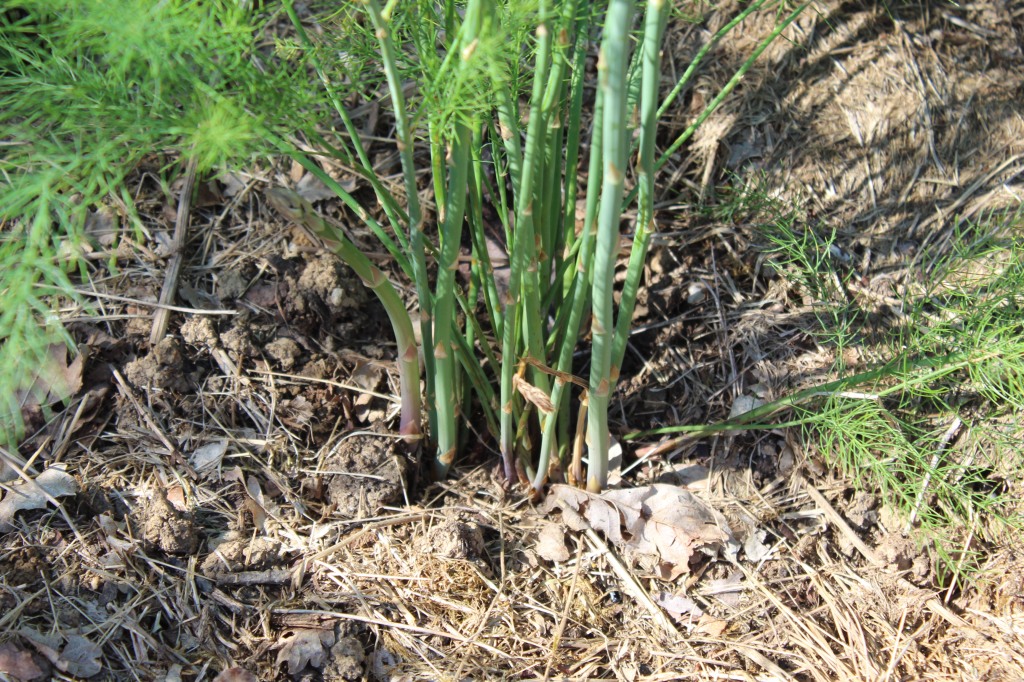
On which subject, it has been interesting to look closely this week at what has been going on in my ‘absence’ and a huge relief (1) to have had a night of proper heavy rainfall at long last and (2) to have regained enough mobility to get back to a few garden tasks. The really good news is that all the beds have remained virtually free of weeds which just goes to show how effective mulch is as a suppressant. Weeding for me these days means working at ground level with a hand fork; I can’t remember the last time I used a hoe, and I much prefer this close contact with the plants and soil plus the opportunity to leave any volunteer seedlings which might be useful. The Not Garden seemed like a good place to start and is a good example of how our holistic approach to gardening works. I started by carefully weeding between the leeks, the most common intruder being various euphorbias including the ubiquitous mole weed. I then used a trowel to spread manure around the plants; it is so well-rotted and dry that it goes on as a top dressing almost in powder form, ideal for feeding soil still in cultivation. I then chopped a pile of comfrey leaves and used them as a mulch on top of the manure; leeks are one of our staple winter and spring foods so it’s important to keep the plants well-fed over many months.

Next to the leeks were a couple of rows of peas, long since harvested. Roger had started removing the plants to make room for the manure pile, so I finished the job, separating the spent plants from the twiggy hazel sticks they had grown up as I went along. The hazel was a by-product of the hedge laying mentioned earlier; the sticks have supported pea plants through the summer and now, dry as a bone, have been piled up to be used as barbecue kindling. I think that ticks two boxes ~ Principle 5 ‘Use and value renewable resources’ and Principle 6 ‘Produce no waste’ ~ quite nicely. The only ‘weeds’ in the peas were self-set calendula which had already dropped their seeds so I removed them, spread some more manure and then put the chopped pea straw on top (there’s no art to that, I just hack things roughly with a pair of garden scissors). On top of that, I laid a few dead rocket and landcress plants that I had left to form seedpods at the other end of the bed; the theory is that winter and the worms will work all that organic matter into the soil and the seeds will germinate to give us some winter salad leaves without any need for raking or sowing. (Yep, lazy gardening once again.) Beyond the peas is a strip of oca, New Zealand spinach and swedes which needed no attention at all. The swedes are another experiment and I’m not holding out for a crop given the tough time they’ve had; the New Zealand spinach has also struggled but looks better for cooler temperatures and a bit of rain and should now give us a decent crop through to the first frosts. The oca has resented the heat but has bounced back this week and hopefully there will be a good harvest of crunchy tubers to come in late autumn.
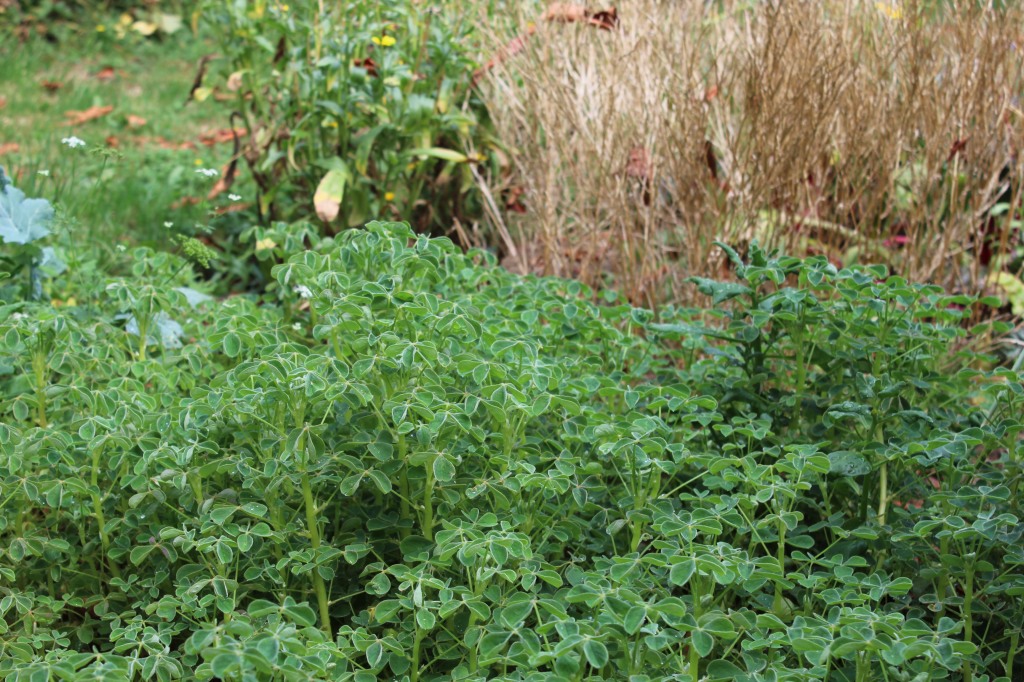
This patch of garden is one of only two that were in cultivation when we moved here and inheriting it was something of a double-edged sword: on the one hand, it gave us a planting area straight away, a mature rosemary bush and a crown of rhubarb I’ve since relocated but it wasn’t without its problems, some of which still persist . . . the euphorbia already mentioned, horseradish which is almost impossible to eradicate with those long persistent tap roots, wild strawberry plants which run amok but never flower or fruit, and the nightmare that is bindweed, to name but a few. Quite a bit of tidying to be done here, then, but in the process I discovered rows of golden and red beetroot I’d forgotten about (I’ve left them in the ground to provide winter salad leaves) and a carpet of young red sorrel plants. The red kale and rainbow chard have struggled but should go well now the weather is kinder; a sprinkle of manure and mulch of grass clippings and chopped dead leaves will keep everything snug and nourished over winter.

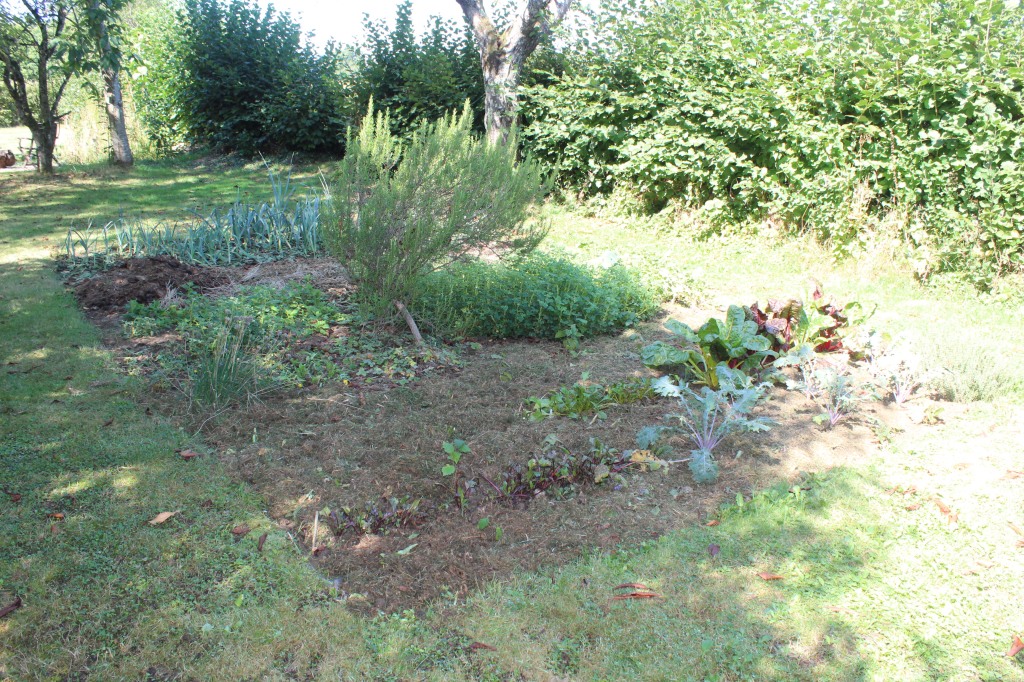
It has occurred to me that this piecemeal approach to garden maintenance is a bit like medieval strip farming but I think that in a system based on abundant polyculture and successional planting, it works a treat. There’s something very satisfying about giving small strips and patches focused attention and responding to their specific needs, rather than giving bulk treatment to the entire cultivated area and it means I can really get to grips with what’s going on in terms of sun and shade, moisture, soil structure, plant health, biodiversity and so on in a meaningful rather than superficial way. The second patch of leeks in the potager also received the muck and mulch treatment but here the weed of the week was white clover, not euphorbia. Now, don’t get me wrong: white clover is a fabulous plant and one that plays a crucial role in our ecosystem, especially as it stayed lush and green and continued to flower whilst everything around it was fried to a crisp. It makes a useful groundcover green manure, fixing nitrogen in the soil, helping to retain moisture, providing cover for beneficial predators like ground beetles and of course, is a fantastic source of nectar. On the downside, its spreading habit can make it invasive and if it grows for too long in the same space, it can cause clover sickness in the soil. I tend to give it the ‘enthusiastic toddler’ treatment, letting it bound about madly wherever it pops up in the patch, then reining it in when it becomes over-excited. So, I cleared it from around the leeks which had become rather engulfed, but I’ve left it to run to its heart’s content in other places, particularly beneath the winter brassicas. (Principle 8 ‘Integrate rather than segregate’ and Principle 10 ‘Use and value diversity’.)

Another candidate for the strip treatment was the row of climbing borlotti beans which have finished cropping well ahead of their Asturian neighbours. I cut the plants off at ground level and left the roots where they will continue to benefit the soil (and much life within it) by decomposing slowly over the coming months. I then unwound the spent plants from their poles which is less of a faff than it sounds, chopped them into smaller bits and scattered them on the ground along with a good dollop of manure. Finally, I gathered some dead phacelia plants from the mandala bed and laid them on top in the hope the seeds will germinate to give a green manure cover over winter. I shall do the same with the Asturian beans when they have finished, probably in a month’s time. The Three Sisters bed was unintentional but has proved an interesting exercise in observation, nonetheless. The beans have been incredibly slow to climb up the corn stalks and are lagging several weeks behind those grown up hazel poles while the volunteer squash trailing beneath are probably the least enthusiastic and productive on the whole patch. I acknowledge this epitome of companion planting as an ancient and wise tradition but on reflection, I’m not convinced it’s appropriate to our situation (Principle 4 ‘Apply self-regulation and accept feedback’).

It’s exactly two years since we decided to buy this property and we have been talking this week about how we now need to flesh out our plans for the next phase of projects here, retaining the flexibility to make changes as we go along but at least moving from some vague ideas to concrete intentions (Principle 7 ‘Design from patterns to details’). We want to keep adding structure and breaking up the space to create more interest and intimacy in the garden while at the same time increasing and enriching the ecosystems and food production within it. It’s not all about the garden, either; an organised outdoor cooking area under the shelter of the outhouse has been on the cards ever since we moved here and it’s definitely time to pin down our ideas and put that particular plan into action. When I set out to draft this blog post, my intention was to hang it loosely on the peg of ‘Observe and interact’ but what I didn’t bargain for was how the other principles of permaculture would muscle in on the act unannounced as the writing took shape. Looking back, there’s only one unaccounted for, Principle 12 ‘Creatively use and respond to change’ ~ but then, in many ways, it’s also precisely what this post has been about. The garden (and house, for that matter) has survived a hot, dry summer and weeks of casual neglect; it’s not looking very tidy or particularly attractive but it is bursting with an abundance of life and food, all managing very nicely on minimum attention. I’m happy that we’re getting there, building the resilience and regeneration that was always part of our plan: the task now is to keep on observing, reflecting, connecting, adapting and ~ most importantly ~ learning and enjoying, as we move forward into the next stage. We’ll keep experimenting, too; after all, what’s the worst that can happen? 😁

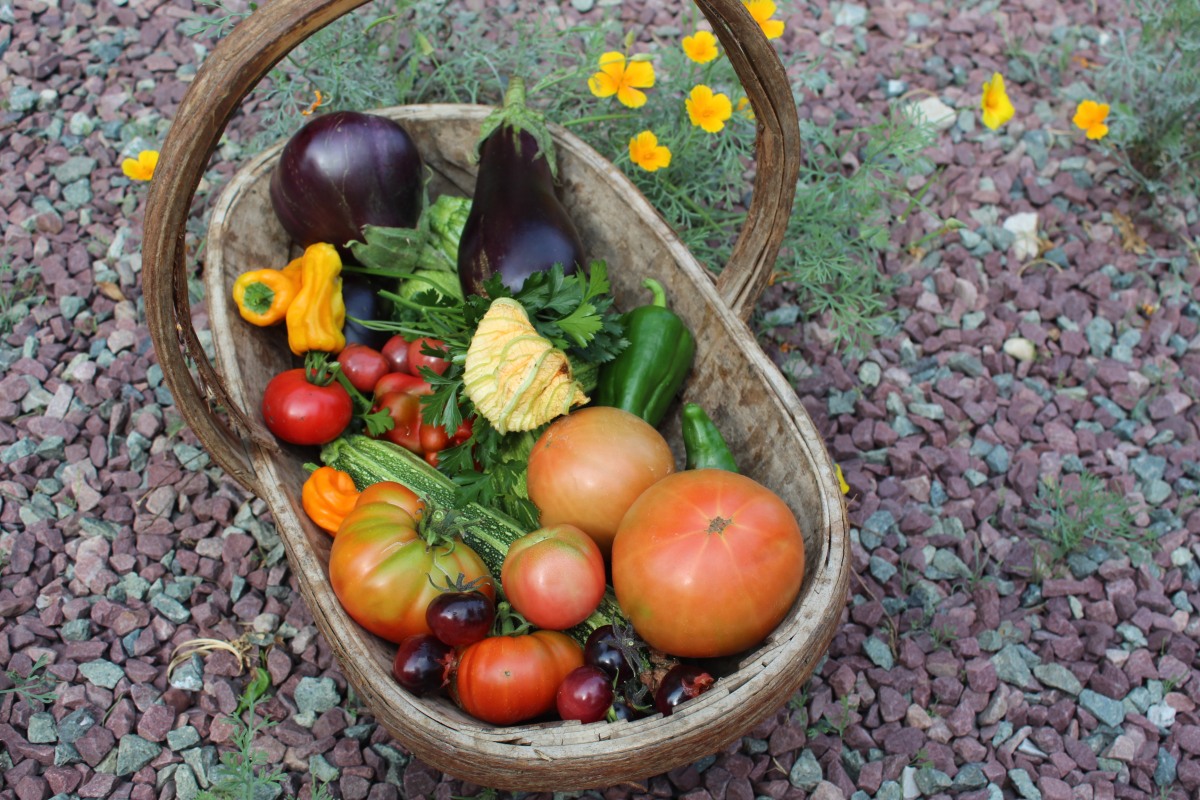
Always intersting to read your blog. What is ‘laying the hedge’? How is that done?
LikeLiked by 1 person
Hedge laying is an old country tradition practised in the British Isles, the idea being to keep a thick base in the hedge to make a good stock-proof barrier and to maintain and encourage biodiversity. Upright growth of trees and shrubs is cut near the base but not all the way through and these ‘pleachers’ are then laid at an angle uphill all along the length of the hedge, supported by vertical wooden stakes at intervals. A decorative binding of supple withies such as hazel is then often woven along the top of the stakes. Although it can look a bit brutal at first, strong new growth soon appears from the bottom and makes a thick hedge which only requires minimal management over the next few years. It is far preferable to the annual flailing with mechanical hedge cutters that is so popular but as it is a slow job and requires a degree of skill, sadly it’s not done as often as it should be. You can find some interesting demonstrations on the internet if my description doesn’t make sense, this one is short and sweet! https://www.youtube.com/watch?v=_7Cq8vxfrfw&ab_channel=Teagasc
LikeLike
It is not “lazy gardening,” it is “smart gardening”!!! Challenging weather in Alaska this year too. Late spring, quick transition to hot and dry for June and 1/2 of July. Non stop rain since. Extremes all the way around. But the garden is still producing and all the cloud cover kept us from having our normal late August killing frost. I hope your back is on the mend. I broke my ring finger in a horse accident in July so I can relate, sort of! A lovely post as always.
LikeLiked by 1 person
Thank you for your lovely comment! Ouch, hope your finger is on the mend, it’s so frustrating to be out of action with so much smart gardening to be done! 😉
LikeLike
Thanks a lot for the nice walkthrough through your garden. I also like David’s principles, they provide a nice rough guideline to follow for all aspects of our life. I’m currently stuck at ‘observe & interact’ but at least it doesn’t make me feel like I’m wasting my time. I’m desperately wanting to go to the following step of ‘Design from patterns to detail’, but there are still a lot of things uncertain as we want to buy a piece of land next to ours, but not sure if we’ll be able to. This will then depend on how we will ‘catch & store’ the rainwater using the energy of gravity.
Enjoy the coolers days and congrats on surviving August!
LikeLiked by 1 person
Thank you, August certainly felt like a case of survival! I think it’s vitally important to take time to observe a new patch of land but it’s also far too tempting to get started on plans and projects, isn’t it? We hated the fact that we had no food coming out of the garden when we moved here, having left a very full garden in Asturias even at the end of December so I have to admit, we did get busy pretty quickly! We’ve taken time since, though, and our next lot of projects have definitely evolved from ongoing observation. It still feels like an adventure, too, which is great! 😊
LikeLiked by 1 person
Lovely garden & those veggies look wonderful!
LikeLiked by 1 person
Thank you! We are certainly blessed with a good harvest.
LikeLike
Wonderful blog post Lis! I have failed to keep up with all the activity (despite your immobility!) happening in your world. So glad to hear you had some decent rain. It is a bit like magic witnessing life bouncing back when the soils have been well watered. Your asparagus bed is enormous! Do you preserve the spears, or is it still too soon to pick? Congratulations on your cauliflower! Having travelled the long journey to cauliflower success, I understand your excitement! It is a hard vegetable to master. Without any real reason or alteration in conditions, after years of failure it decides to succeed. For a humble vegetable, it is very fickle! I have a couple of David Holmgren’s books at home. My favourite is Retrosuburbia. It is a truly comprehensive and thought-provoking tome. Well worth getting your hands on if you can. Lovely photos as usual. It is always so nice and inspiring to see your garden!
LikeLiked by 1 person
Hello, Paula! Thanks again for your lovely comment. Yes, hooray for cauliflowers, I’m hoping for even better things next year ~ let’s face it, two would be a 100% improvement! We haven’t picked the asparagus yet and as it’s been grown from seed, strictly speaking we should leave it until 2024 but I can’t see that happening! We definitely need to explore preserving ideas. Hope you are enjoying the shift into spring in your corner of the world. 😊
LikeLike